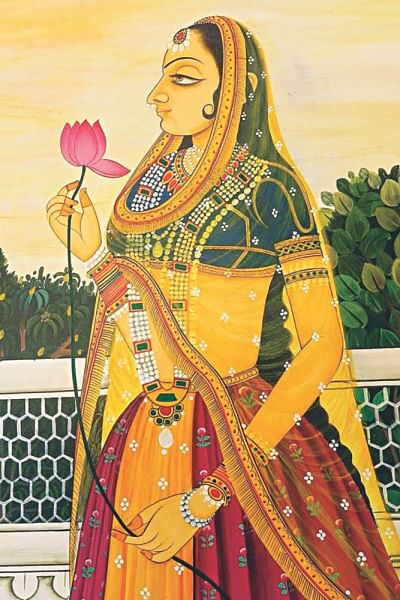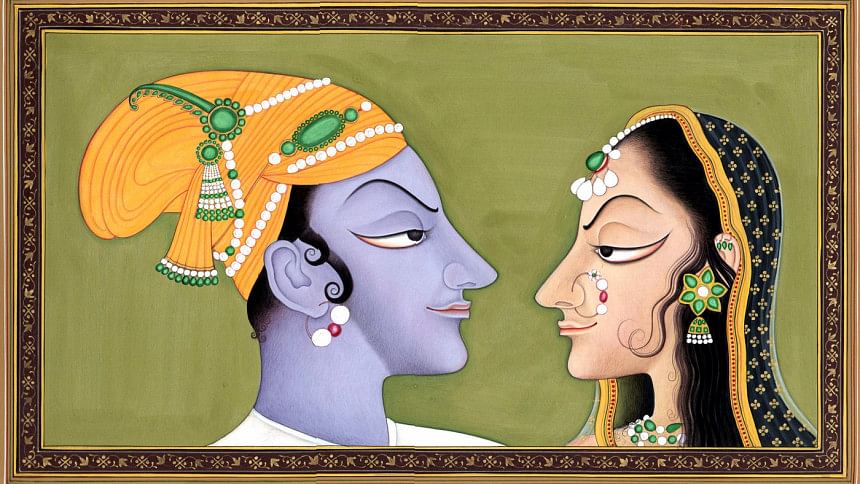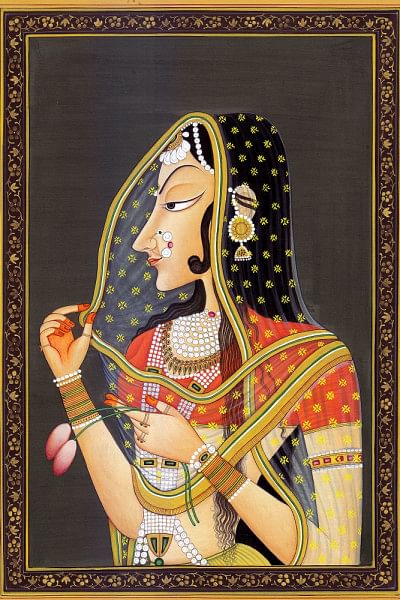Bani Thani: brushwork for the divine

It is one of the greatest romances ever; the tale of a union that elevates love and desire, the purest of all human emotions, to a godly realm. Lord Krishna, his beloved Radha and the love they share has a multitude of interpretations within Hinduism, but no soul shall ever deny that while Krishna enchants the world, Radha enchants even Him.
The tale of Bani Thani is one with a different set of protagonists, each worshipping love, and each eventually being worshipped as lovers.
She is the iconic belle of a series of artworks originating from mid-18th century Rajasthan, and her presence is sealed in history. Bani Thani was Vishnupriya, mistress of King Sawant Singh, the ruler of Kishangarh and as time remembers, eventually became one of his wives. Although now forgotten, her image as Bani Thani — the decked out lady —is timeless.
Credits go to Nihal Chand, the court artist and an exponent of Rajput miniature paintings, but also to the king himself, who commissioned repeated depictions of his beloved in the image of the most beautiful women ever known.
In this iconic piece of Indian miniature painting, we find a confluence of genres of art, and of course, the depiction of the most cherished of all human emotions-- love. In scriptures, Krishna often appears dark-skinned; most commonly in shades of blue. In the well-established Kishangarh School, he is unmistakably in a subtle hue of blue, as he is supposed to appear to the purest of his devotees.
The King and Vishnupriya were both poets, accomplished in composing verses on spirituality and praising the Lord. Singh, in particular, was known for his devotion, and passionate worship of Krishna; he took upon himself the name — Nagari Das, which leaves art historians drawing the hyperbole — "Is Bani Thani an image of Vishnupriya, as Lord Krishna himself might have seen Radha?"

Most unlikely, but even if one sets art aside, the legend of Vishnupriya was that of an ideal disciple of Radha, and like the goddess she worshipped, she too shared some of Radha's attributes.
To begin with, Vishnupriya was an unmatched beauty, which grabbed the attention of the king, but there is more to the story. It was not only her outward appearance but also her inner creativity, her musical and poetic prowess that added to her charisma. As a matter of fact, Bani Thani was known as Rasik Bihari, her much revered pen name as a poetess.
Looking at Chand's work, it is easy to realise why Sawant Sing was head over heels. Accentuated facial features are a key to Kishangarh art, and even the gopis are depicted with similar sharp features. But Bani Thani is rendered in a profile, she is one with a pointed chin; her eyes — enigmatic with a magical lotus-like appearance, and her arched eyebrows are more demi-goddess than mortal.
This, however, has been Radha's description in oral traditions, and widely seen in ancient Indian sculptures. Bani Thani has a Radha-like bodily lustre, like 'molten gold'; locks of curling hair lazily falling on the side; her expanded doe-eyes, enigmatic with profuse use of dark mascara. In texts, her nose had a more distinct description, "beautiful as a sesame flower and the tip decorated with a pearl" — something evident in the portrait itself.
The oral tradition continues, Radha wore light-coloured clothes during the full moon and dark colours in its absence. Her favourite outfit is a blue sari and shawl, matched with a coloured blouse (in pink) that delights Krishna. Radha's upper garment would often be red, like a ruby, and it is the favourite of Krishna, while her lower garment is the colour of a blue cloud, something that she prefers.

The portrayal of Bani Thani is not true to the lore in its exact form, extrapolated, yet, hinting to the origin. Her attire is in rich shades of orange overwhelming a grey background, which while spread throughout the painting, is used to highlight the central female figure. The elaborate jewels, mostly in white possibly denoting the pure aura of the one depicted, and in lieu with the near divine.
What I find most striking in the whole composition is the way Bani Thani holds the translucent, bejewelled veil. Using only her index and thumb, she touches the dupatta, bordered with gold, as if in an effort on her part to be the beacon of modesty — a characteristic often solely attributed to Radha.
But even in all her modesty and shyness, Bani Thani has a maddening aura and one can sense the wild attraction Sawant Singh might have felt for her centuries ago. The love of Sawant Sing and Vishnupriya is now a larger than life tale, framed on canvas by the able hands of Nihal Chand. Sawant Sing is still remembered as a devotee of Krishna and the unabashed lover of Vishnupriya.
As for Bani Thani — she remains half-real; half-imaginary. Half-Radha and half — any loved one!
EPILOGUE
The romance between Singh and Vishnupriya has a befitting end. Historians claim that at a point in his life, Savant Singh chose seclusion over power and moved to Brindaban, outside Kishangarh, the place of Krishna's youth. Deeply immersed in the devotion of the Lord, along with his beloved Vishnupriya, they spent the last days of their lives together.
Photo: Collected

 For all latest news, follow The Daily Star's Google News channel.
For all latest news, follow The Daily Star's Google News channel. 



Comments